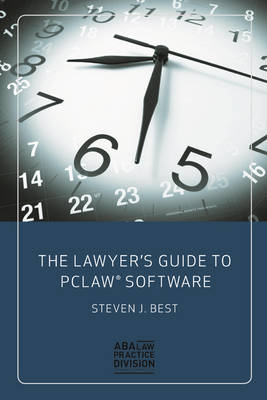
The Lawyer's Guide to Pclaw Software
American Bar Association (Verlag)
978-1-63425-056-6 (ISBN)
- Titel ist leider vergriffen;
keine Neuauflage - Artikel merken
This book will cover: *Concepts and functions of PCLaw(R)*Properly setting up the program to work best for your practice*Effective organization of both clients and their cases*Accurately calculating your fees and time*Expense recovery*Financial management, including check writing, billing, and client receipts*Closing your months and running reports*Using advanced features of the softwareAdapting PCLaw(R) to most every type of law practice*And much more!
Steven J. Best is an attorney and a founding partner of the Affinity Consulting Group, a well-known and well-respected law office practice management and technology company. With an educational background in law, accounting and economics, Steve consults with law firms throughout the United States on law office software as well as sophisticated practice management and document management issues. After practicing law for ten years, Steve began his career as a legal technology consultant helping lawyers and their staff understand PCLaw(R). Although he'd not used PCLaw in his practice, he immediately recognized PCLaw as an outstanding time billing and accounting software system made for law firms of all disciplines. Because of an undergraduate concentration in accounting, Steve's understanding of debits and credits, coupled with his experience as an attorney, made PCLaw a natural fit for his consulting practice. Steve is also a certified consultant/trainer, maintaining certifications in many law office software products including time/billing/ accounting, practice management, document management, PDF production, document assembly and paperless office packages. Steve also is a national speaker at many CLE programs throughout the US and Canada. Steve is currently the vice-chair of the 2015 ABA TechShow planning board, and is slated to be the chair of the 2016 TechShow planning board. He is also an active member of theABA's Law Practice Management Division. In his free time, Steve enjoys composing music, playing piano, running, cooking, and has recently started appreciating the art of Yoga. He is married and has two children.
About the Author ... xi Acknowledgments ... xiii Foreword ... xv Introduction ... xvii Chapter 1 System Settings 1 Firm Tab ... 1 Other Tab ... 2 Data Entry Tab ... 5 Banking Tab ... 10 Tax Tab ... 12 Matter Tab ... 12 Billing Tab ... 13 Past Due/Interest Tab ... 15 Memorized Transactions Tab ... 16 Front Office Tab ... 16 Client Intake Tab ... 18 Provincial Tab (For Firms in Canada) ... 19 Chapter 2 Workstation and Connection Settings 21 Data Entry Tab ... 22 Calendar Tab ... 24 Other Tab ... 26 Perform Data Copy ... 27 Report ... 27 Accounting and Reporting ... 27 Documents Tab ... 28 Connection Settings ... 29 Outlook Tab ... 31 Chapter 3 Lists 35 Appointment Codes ... 36 Bank Accounts ... 36 Contact Types ... 39 Department Codes... 39 Document Types ... 40 Explanation Codes ... 40 G/L Accounts ... 46 Holidays ... 48 Lawyers and Rates ... 49 Location Codes ... 55 Matter Bill Settings ... 55 Rate Categories ... 56 Referral Sources ... 57 Task Codes ... 57 Types of Law ... 59 Chapter 4 Client and Matter Manager 61 Client Manager (Main Tab) ... 61 Client Introducing Lawyer ... 63 New Matter Defaults ... 64 Client Manager (Matters Tab) ... 64 Matter Manager ... 65 Matter Manager: Main Tab ... 65 Name & Address Area of the Main Tab ... 68 Billing Tab ... 69 Settings Tab ... 75 Summary Tab ... 76 Additional Tabs ... 77 Chapter 5 Time and Fee Entries 79 Time Sheet ... 79 Fee Sheet ... 83 Quick Charge ... 85 Quick Timer... 85 Time Entry via the Calendar ... 85 The Time Entry Advisor ... 86 Other Time Entry Methods ... 87 Correcting Time and Fees ... 88 Correcting Time/Fees Using the Register ... 88 Correcting Time in the Matter Manager ... 90 Correcting Time by Drilling Down on Reports ... 90 Chapter 6 Expense Recovery 91 Expense Recoveries in General ... 91 Basics of the Expense Recovery Window ... 92 Creative Use of Expense Recoveries ... 95 Accounting Implications of the Expense Recovery Function... 96 Correcting Expense Recoveries ... 97 Transferring Expenses ... 98 Chapter 7 General Checks, Accounts Payable, and Deposit Slips 101 General Checks ... 101 Check Area ... 102 Allocation (Grid) Area of a General Check ... 103 General Checks and the G/L ... 104 Writing a General Check for an Overhead Expense ... 104 When You Are Charging a Matter ... 106 Accounts Payable ... 108 Benefits of Accounts Payable ... 108 Overview of A/P Use ... 109 New Payable ... 111 Recurring Transactions ... 112 Alternative Payable Entry ... 113 Editing Payables ... 114 G/L Implications of Allocated Payables ... 115 Processing Payables ... 115 Deposit Slips ... 120 Benefit of the Deposit Slip Module ... 120 Using the Deposit Slip Module ... 121 Chapter 8 Trust 125 Setting Up Trust ... 126 Trust Receipt ... 127 Trust Check ... 128 Trust-to-General Transfer ... 130 Auto Fill Function ... 132 Three-Point Trust Account Reconciliation ... 133 G/L Implications of the Trust-to-General Transfer Function ... 134 Matter-to-Matter Transfer ... 135 Bank-to-Bank Transfer ... 136 Chapter 9 Billing 139 Prebill ... 139 The Purpose of the Prebill ... 139 Prebill Main Tab ... 140 Output Selections ... 142 Prebill-Matter Tab ... 143 Fees Tab ... 144 Disbs Tab ... 144 Receipts Tab ... 144 Trust Tab ... 145 Options Tab ... 145 Editing Items on the Prebill ... 149 Prebill Tips ... 150 Create Bill ... 151 Select Charges (Same as in Prebill) ... 153 Prompt for Changes to Billed Amounts ... 153 E-Mailing Bills and the E-Mail Queue ... 161 Enabling the E-mail Queue ... 162 Recreate Bill ... 168 Undo Bill ... 169 Undoing Bills from a Closed Month ... 170 Quick Bills ... 171 Special Billing Scenarios ... 173 Split Billing ... 173 Electronic Billing ... 175 Flat Fee Billing ... 176 Settlement Statements ... 178 Contingency Fee Billing ... 178 Chapter 10 Past Due, Interest, and Billing Adjustments 181 Creating Past Due Notices ... 181 Common Tab Matter Selection Area ... 182 Invoices Area ... 183 Interest ... 184 Change/Write-Off Bill ... 187 Initial Considerations ... 187 Changing the Value of a Bill Produced in a Prior Action ... 188 Bill Details Area ... 189 Chapter 11 Receipts 191 The General Bank-in General ... 191 Receiving Money ... 191 Bank Account Summary ... 193 Firm Receipt... 194 General Retainer ... 194 Entering a General Retainer ... 195 Accounting Implications of the General Retainer ... 197 Applying a General Retainer to an A/R Balance ... 198 Receive Payment ... 199 The Basics of Receiving Payments ... 199 Modifying Payment Allocations ... 202 Accounting Implications of the Receive Payment Function ... 203 Overpayments ... 204 Chapter 12 Month-End and Closing Matters 209 Month-End-Introduction ... 209 Reconciling the Bank Accounts ... 210 Starting the Bank Reconciliation ... 211 Marking Items ... 213 A Special Note About "New Errors" ... 213 Service Charges ... 214 Prior Items... 215 Completing the Bank Reconciliation ... 216 Closing Your Months, Years, and Matters ... 219 Producing Financial Statements ... 219 End of Month ... 222 End of Year ... 223 Closing Clients and Matters ... 224 Deactivate or Archive? ... 226 Chapter 13 Budgeting 227 Matter Budgeting ... 227 Lawyer Budgeting ... 227 General Ledger Budgeting ... 228 Chapter 14 The Template Editor and Report Layout Editor 231 The Template Editor: Introduction ... 231 Opening the Template Editor ... 233 Template Editor Toolbar ... 234 Creating Sections ... 235 Miscellaneous Sections ... 236 Adding, Removing, and Resizing Sections ... 237 Detail Sections ... 239 Element Placement ... 240 Saving the Template ... 247 Report Layout Designer ... 248 Chapter 15 PCLaw Extras 253 PCLaw Front Offi ce Features Overview ... 253 Contact Manager ... 254 Calendar ... 255 PCLaw Document Manager ... 256 Managing E-Mail with PCLaw ... 258 PCLaw Dashboards ... 259 My Practice ... 259 My Clients ... 260 My Business ... 261 Conclusion ... 262 Appendix A: PCLaw Reports 263 Appendix B: Sample General Ledger 279 Index 283
| Erscheint lt. Verlag | 7.7.2015 |
|---|---|
| Verlagsort | Chicago, IL |
| Sprache | englisch |
| Maße | 154 x 229 mm |
| Gewicht | 435 g |
| Themenwelt | Recht / Steuern ► EU / Internationales Recht |
| Recht / Steuern ► Privatrecht / Bürgerliches Recht ► Berufs-/Gebührenrecht | |
| Recht / Steuern ► Privatrecht / Bürgerliches Recht ► IT-Recht | |
| ISBN-10 | 1-63425-056-7 / 1634250567 |
| ISBN-13 | 978-1-63425-056-6 / 9781634250566 |
| Zustand | Neuware |
| Informationen gemäß Produktsicherheitsverordnung (GPSR) | |
| Haben Sie eine Frage zum Produkt? |
aus dem Bereich


